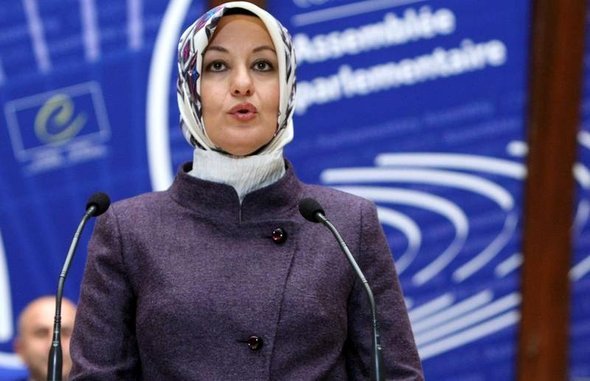Hijab and High Heels
The model's upper body is clad in shiny white silk, tight drainpipe jeans cover her slim legs; she is also wearing a tapered leather coat with fur trim, and knee-high leather boots with towering heels. It's Saturday evening in Istanbul, in front of the hip Black Lounge, a restaurant-bar not far from the Bosphorus. The woman in the head-turning outfit is called Gülbahan – and she's wearing a headscarf. "I won't be dictated to on any score – and the hijab, the headscarf, makes my style even more elegant," she says.
Up to now, it was thought that Muslim women must make a choice between two looks – dressing in accordance with religious stipulations, with a headscarf – or western-style with hair uncovered. In contemporary Turkey, however, the traditional and the modern are now being blended to make a fashion statement. It's a style that's been propagated for almost two years by the fashion magazine "Ala", which can be translated as "dignity".
And public opinion is divided over "Ala". It's primarily Islamist groups that are scandalized: writing in the newspaper "Zaman", the well-known Muslim scholar and conservative populist Fethullah Gülen accuses it of betraying the profound values of Islam for the vile superficiality of aesthetic appearance. Leftwing liberal critics writing in the newspaper "Radikal", on the other hand, joke that "Ala" still isn't showing enough leg.
Culture shock in reverse
Most Europeans flicking through a copy of "Ala" might also raise their eyebrows. Not only are the models presenting the latest lines in headscarf fashion, they also wear figure-hugging pencil skirts and leather jackets with attitude. This makes it all the most surprising to learn that most of the women who read this glossy magazine are members of the new Turkish middle class, which is politically aligned to the governing Islamist-leaning AKP.
In contrast to other magazines on the Islamic spectrum, "Ala" rarely publishes devotional material of a religious nature. Readers are more likely to find profile pieces on Muslim career women or well-balanced portraits of leading conservative figures.
It is above all the fashion presented in "Ala" that appears to best reflect social developments in Turkey over the past decade. While for the "New York Times", the magazine represents a kulturkampf between sacred and secular Turkey, perhaps "Ala" is in actual fact an expression of the rapprochement taking place between the various different worlds present in today's Turkey.
Just a few years ago, western districts of Istanbul such as Kadiköy were the stylish bastions of the nation's western-orientated elite. But Turkey's economic boom has also altered society's economic structure. Prosperity is no longer the preserve of the upper classes, and everyday luxury goods are now affordable by sections of the middle classes. Status symbols are an expression of wealth and success – also for Turks who would define themselves as religious.
Ottoman splendour en vogue
In downtown Istanbul, just as in Ankara and Kayseri, there are expensive furniture boutiques showcasing Islamic design for the home: gold ornamental Koran suras for example, chiselled into Italian marble.
Ottoman splendour is en vogue again and blends with western glamour – a trend linked to dubious historical references to the pre-Republican era made by the Erdogan government. "Ala" magazine positioned itself squarely in the gap in the market created by this social upheaval. Previously, the Turkish magazine market was dominated by revealing showbiz magazines featuring actresses from the world of films and soap operas, as well as regional versions of western titles such as "Vogue".
But right from the outset, the concept of "Ala" was to counter the straightforward adaptation of western role models with the image of a Turkish woman who is both traditional and sophisticated: or as "Ala" publisher Mehmet Volkan Atay so succinctly describes it, "Hijab & Heels".

The young Turkish-German fashion designer Ayse Kilic, who regularly creates striking and avant-garde illustrations for "Ala", believes that the religious turban, which completely covers the hair, is no barrier whatsoever to fashion consciousness, style and elegance. In her view, it's much more a case of the religious element serving as an additional inspiration for fashionable combinations: "I hope there's a great future for this form of modern, Islamic fashion with the headscarf, Insha'Allah!" she says.
Affiliation to the traditional and the modern
It does indeed appear to be the case that there is a huge market for magazines like "Ala" in European migrant communities, and not just in Turkey. Dr. Reyhan Sahin – also known as the rapper "Lady Bitch Ray" – has just written a doctoral thesis on the subject of hijab fashion. She believes that the stylistic blend of ultra-feminine clothing and the headscarf is a phenomenon that's continually growing in popularity. For these women, this is a way of expressing their dual affiliation: to both the traditional, and the modern.
It's hardly surprising then that First Ladies Emine Erdogan and Hayrünissa Gül are being touted as new style icons of glamorous elegance – and not just in the Turkish media: They dress for public appearances in a combination of very slim-fitting, high-necked business suits and silk headscarves, plateau high heels by hip label Louboutin and classic accessory highlights such as gloves. A look that recalls western film divas of the 1940s, enriched with an oriental touch.
Islamic fashion has created a completely new aesthetic, a classic reference to the old European bourgeoisie that's been taken up by the new affluent social milieu in the Middle East. New labels are also being established in Europe – the Geneva studio New Hijab, for example.
Company founder Maryam Saeedynejad wants her collections to appeal to the "modern Islamic woman": "We're aiming for a blend of classic and class, the sort of look that used to come out of France or Italy. It's all about putting a modern twist on oriental traditions."
Marcel Malachowski
© Qantara.de 2012
Translated from the German by Nina Coon
Editor: Lewis Gropp/Qantara.de
